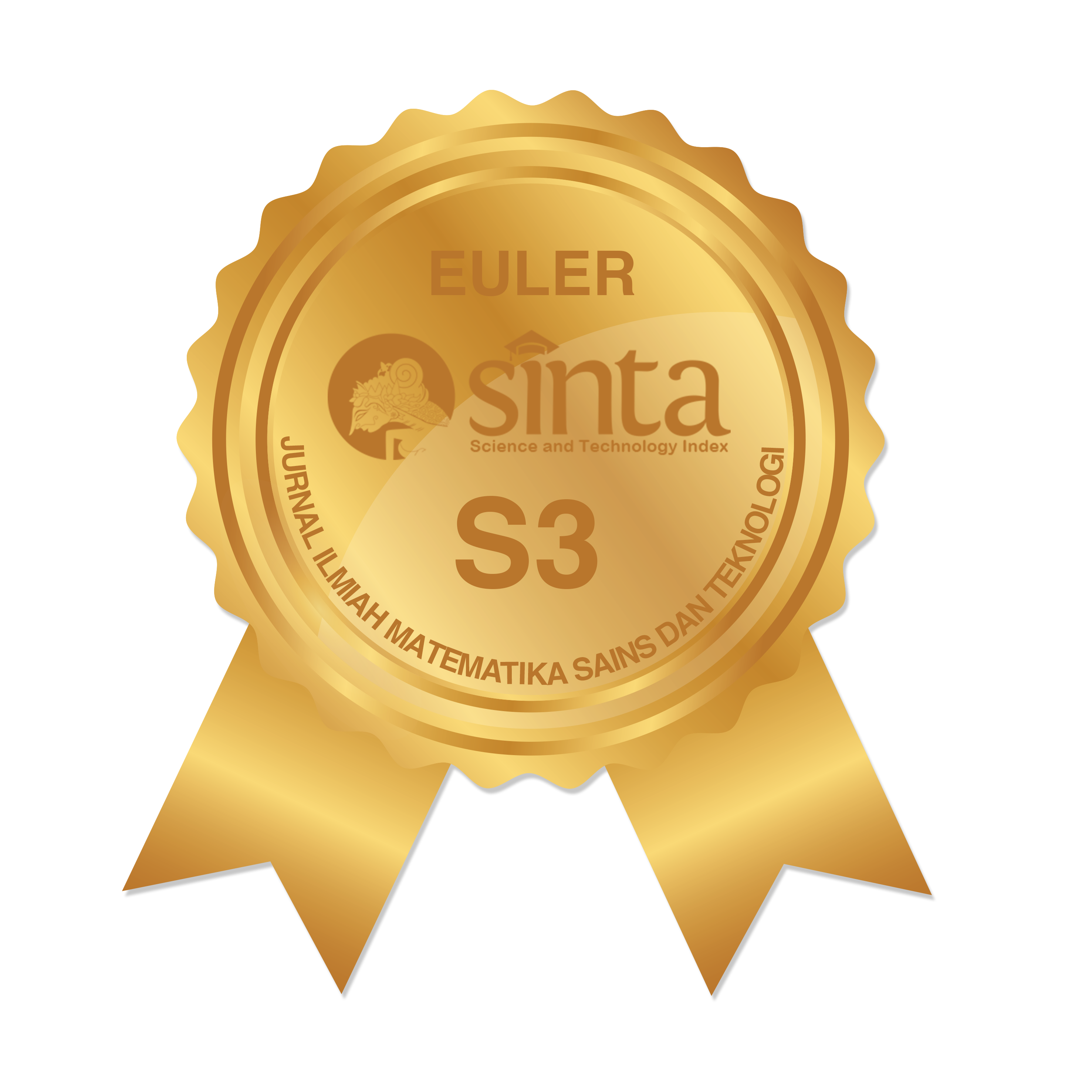Optimal Control for a COVID-19 and Tuberculosis Co-Infection Model with Asymptomatic COVID-19 Carriers
Abstract
Keywords
Full Text:
PDFReferences
WHO, "Global tuberculosis report," 2022.
WHO, "WHO Coronavirus (COVID-19) dashboard," 2023. [Online]. Available: https://covid19.who.int/
WHO, "Global tuberculosis programme: Tuberculosis and COVID-19," 2020. [Online]. Available: https://www.who.int/teams/global-tuberculosis-programme/covid-19
Q. Wang, S. Guo, X. Wei, Q. Dong, N. Xu, H. Li, J. Zhao, and Q. Sun, "Global prevalence, treatment and outcome of tuberculosis and COVID-19 coinfection: a systematic review and meta-analysis," BMJ Open, vol. 12, no. 6, 2017, doi: 10.1136/bmjopen-2021-059396.
TB/COVID-19 Global Study Group, "Tuberculosis and COVID-19 co-infection: description of the global cohort," The European respiratory journal, vol. 59, no. 3, 2022, doi: 10.1183/13993003.02538-2021.
W. M. Song, J. Y. Zhao, Q. Y. Zhang, S. Q. Liu, X. H. Zhu, Q. Q. An, T. T. Xu, S. J. Li, J. Y. Liu, N. N. Tao, Y. Liu, Y. F. Li, and H. C. Li, "COVID-19 and Tuberculosis Coinfection: An Overview of Case Reports/Case Series and Meta-Analysis," Frontiers in Medicine, vol. 8, 2021, doi: 10.3389/fmed.2021.657006.
S. Colby and R. Shah, "TB reactivation following COVID-19 infection," Chest, vol. 162, no. 4, 2022, doi: 10.1016/j.chest.2022.08.255.
M. Khayat, H. Fan, and Y. Vali, "COVID-19 promoting the development of active tuberculosis in a patient with latent tuberculosis infection: A case report," Respiratory Medicine Case Reports, vol. 32, 2021, doi: 10.1016/j.rmcr.2021.101344.
P. Daneshvar, B. Hajikhani, F. Sameni, N. Noorisepehr, F. Zare, N. Bostanshirin, S. Yazdani, M. Goudarzi, S. Sayyari, and M. Dadashi, "COVID-19 and tuberculosis coinfection: An overview of case reports/case series and meta-analysis of prevalence studies," Heliyon, vol. 9, no. 2, 2023, doi: 10.1016/j.heliyon.2023.e13637.
A. Ahmad, U. Atta, M. Farman, K. S. Nisar, H. Ahmad, and E. Hincal, "Investigation of lassa fever with relapse and saturated incidence rate: mathematical modeling and control," Modelling Earth Systems and Environment, vol. 11, no. 202, 2025, doi: 10.1007/s40808-025-02370-7.
M. Meena, M. Purohit, Shyamsunder, S. Purohit, D. Baleanu, and D. Suthar, "A novel fractionalized inveigation of tuberculosis disease," Applied Mathematics in Science and Engineering, vol. 32, no. 1, 2024, doi: 10.1080/27690911.2024.2351229.
Shyamsunder, S. Bhatter, K. Jangid, A. Abidemi, K. Owolabi, and S. Purohit, "A new fractional mathematical model to study the impact of vaccination on COVID-19 outbreaks," Decision Analytics Journal, vol. 6, 2023, doi: 10.1016/j.dajour.2022.100156.
F. K. Alalhareth, U. Atta, A. H. Ali, A. Ahmad, and M. H. Alharbi, "Analysis of leptospirosis transmission dynamics with environmental effects and bifurcation using fractional-order derivative," Alexandria Engineering Journal, vol. 80, pp. 372–382, 2023, doi: http://dx.doi.org/10.1016/j.aej.2023.08.063.
K. G. Mekonen, S. F. Balcha, L. L. Obsu, and A. Hassen, "Mathematical modeling and analysis of TB and COVID-19 coinfection," Journal of Applied Mathematics, pp. 1–20, 2022, doi: 10.1155/2022/2449710.
K. G. Mekonen, L. L. Obsu, and T. G. Habtemichael, "Optimal control analysis for the coinfection of COVID-19 and TB," Arab Journal of Basic and Applied Sciences, vol. 29, no. 1, pp. 175–192, 2022, doi: 10.1080/25765299.2022.2085445.
M. S. Goudiaby, L. D. Gning, M. L. Diagne, B. M. Dia, H. Rwezaura, and J. M. Tchuenche, "Optimal control analysis of a COVID-19 and tuberculosis co-dynamics model," Informatics in Medicine Unlocked, vol. 28, 2022, doi: 10.1016/j.imu.2022.100849.
A. B. Diabaté, B. Sangaré, and O. Koutou, "Optimal control analysis of a COVID-19 and Tuberculosis (TB) co-infection model with an imperfect vaccine for COVID-19," SeMA Journal, 2023, doi: 10.1007/s40324-023-00330-8.
Z. S. Kifle and L. L. Obsu, "Co-dynamics of COVID-19 and TB with COVID-19 vaccination and exogenous reinfection for TB: An optimal control application," Infectious Disease Modelling, vol. 8, no. 2, 2023, doi: 10.1016/j.idm.2023.05.005.
M. M. Ojo, O. J. Peter, E. F. D. Goufo, and K. S. Nisar, "A mathematical model for the co-dynamics of COVID-19 and tuberculosis," Mathematics and Computers in Simulation, vol. 207, pp. 499–520, 2023, doi: 10.1016/j.matcom.2023.01.014.
L. Pontryagin, V. Boltyanskii, R. Gramkrelidze, and E. Mischenko, "The mathematical theory of optimal processes." New York – London: John Wiley & Sons, 1962, doi: 10.1002/zamm.19630431023.
S. Lenhart and J. T. Workman, "Optimal control applied to biological models." New York: Chapman and Hall/CRC, 2007, doi: 10.1201/9781420011418.
G. G. Mwanga, H. Haario, and V. Capasso, "Optimal control problems of epidemic systems with parameter uncertainties: Application to a malaria two-age-classes transmission model with asymptomatic carriers," Mathematical Biosciences, vol. 261, pp. 1–12, 2015, doi: 10.1016/j.mbs.2014.11.005.
M. S. Kumar, D. Surendran, M. S. Manu, P. S. Rakesh, and S. Balakrishnan, "Mortality due to TB-COVID-19 coinfection in India," International Journal of Tuberculosis and Lung Disease, vol. 25, no. 3, pp. 250–251, 2021, doi: 10.5588/ijtld.20.0947.
K. A. Alene, K. Wangdi, and A. C. A. Clements, "Impact of the COVID-19 pandemic on tuberculosis control: an overview," Tropical Medicine and Infectious Disease, vol. 5, no. 3, 2020, doi: 10.3390/tropicalmed5030123.
Y. Chen, Y. Wang, J. Fleming, Y. Yu, Y. Gu, C. Liu, L. Fan, X. Wang, M. Cheng, L. Bi, and Y. Liu, "Active or latent tuberculosis increases susceptibility to COVID-19 and disease severity," MedRxiv, 2020, doi: 10.1101/2020.03.10.20033795.
B. J. Schroers, "Ordinary differential equations: a practical guide." New York: Cambridge University Press, 2011, doi: 10.1017/CBO9781139057707.
A. B. Gumel, E. A. Iboi, C. N. Ngonghala, and G. A. Ngwa, "Mathematical assessment of the roles of vaccination and non-pharmaceutical interventions on COVID-19 dynamics: a multigroup modeling approach," MedRxiv, pp. 1–24, 2021, doi: 10.1101/2020.12.11.20247916.
F. B. Agusto, I. V. Erovenko, A. Fulk, Q. Abu-Saymeh, D. Romero-Alvarez, J. Ponce, S. Sindi, O. Ortega, J. M. S. Onge, and A. T. Peterson, "To isolate or not to isolate: The impact of changing behavior on COVID-19 transmission," BMC Public Health, vol. 22, no. 138, 2022, doi: 10.1186/s12889-021-12275-6.
E. A. Iboi, C. N. Ngonghala, and A. B. Gumel, "Will an imperfect vaccine curtail the COVID-19 pandemic in the U.S.?" Infectious Disease Modelling, vol. 5, pp. 510–524, 2020, doi: 10.1016/j.idm.2020.07.006.
A. Omame, M. Abbas, and C. P. Onyenegecha, "A fractional-order model for COVID-19 and tuberculosis co-infection using Atangana-Baleanu derivative," Chaos, Solitons, & Fractals, vol. 153, 2021, doi: 10.1016/j.chaos.2021.111486.
M. L. Diagne, H. Rwezaura, S. Y. Tchoumi, and J. M. Tchuenche, "A mathematical model of COVID-19 with vaccination and treatment," Computational and Mathematical Methods in Medicine, 2021, doi: 10.1155/2021/1250129.
D. Okuonghae and S. E. Omosigho, "Analysis of a mathematical model for tuberculosis: What could be done to increase case detection," Journal of Theoretical Biology, vol. 269, no. 1, pp. 31–45, 2011, doi: 10.1016/j.jtbi.2010.09.044.
S. J. Brozak, B. Pant, S. Safdar, and A. B. Gumel, "Dynamics of COVID-19 pandemic in India and Pakistan: A metapopulation modelling approach," Infectious Disease Modelling, vol. 6, pp. 1173–1201, 2021, doi: 10.1016/j.idm.2021.10.001.
J. David, S. A. Iyaniwura, P. Yuan, Tan, J. Kong, and H. Zhu, "Modeling the potential impact of indirect transmission on COVID-19 epidemic," MedRxiv, 2021, doi: 10.1101/2021.01.28.20181040.
F. B. Agusto, E. Numfor, K. Srinivasan, E. A. Iboi, A. Fulk, J. M. S. Onge, and A. T. Peterson, "Impact of public sentiments on the transmission of COVID-19 across a geographical gradient," PeerJ, 2023, doi: 10.7717/peerj.14736.
WHO, "Guidelines for the management of sexually transmitted infections," 2003.
P. Driessche and J. Watmough, "Reproduction numbers and sub-threshold endemic equilibria for compartmental models of disease transmission," Mathematical Biosciences, vol. 180, no. 1–2, pp. 29–48, 2002, doi: 10.1016/S0025-5564(02)00108-6.
Q. Wang, Y. Cao, X. Liu, Y. Fu, J. Zhang, Y. Zhang, L. Zhang, X. Wei, and L. Yang, "Systematic review and meta-analysis of tuberculosis and COVID-19 co-infection: Prevalence, fatality, and treatment considerations," PLoS Neglected Tropical Diseases, vol. 18, no. 5, pp. 1–19, 2024, doi: 10.1371/journal.pntd.0012136.
W. H. Fleming and R. W. Rishel, "Deterministic and stochastic optimal control." New York: Springer, 2012, doi: 10.1007/978-1-4612-6380-7.
DOI: https://doi.org/10.37905/euler.v13i1.31076
Refbacks
- There are currently no refbacks.
Copyright (c) 2025 Sailah Ar Rizka, Regina Wahyudyah Sonata Ayu, Dewi Ika Ainurrofiqoh, Merysa Puspita Sari, Nadia Kholifia

This work is licensed under a Creative Commons Attribution-NonCommercial 4.0 International License.
Euler : Jurnal Ilmiah Matematika, Sains dan Teknologi has been indexed by:
EDITORIAL OFFICE OF EULER : JURNAL ILMIAH MATEMATIKA, SAINS, DAN TEKNOLOGI |
 | Department of Mathematics, Faculty of Mathematics and Natural Science, Universitas Negeri Gorontalo Jl. Prof. Dr. Ing. B. J. Habibie, Tilongkabila, Kabupaten Bone Bolango 96554, Gorontalo, Indonesia |
 | Email: euler@ung.ac.id |
 | +6287743200854 (WhatsApp Only) |
 | Euler : Jurnal Ilmiah Matematika, Sains dan Teknologi (p-ISSN: 2087-9393 | e-ISSN:2776-3706) by Department of Mathematics Universitas Negeri Gorontalo is licensed under a Creative Commons Attribution-NonCommercial 4.0 International License. Powered by Public Knowledge Project OJS. |















